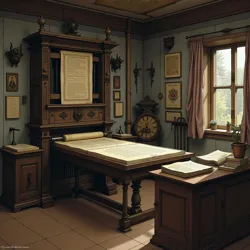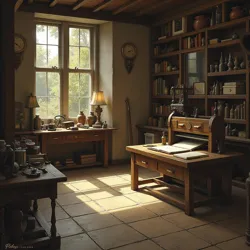Fellowship of Concerned Printers
The Fellowship of Concerned Printers (FCP) was a clandestine organization of master printers, typesetters, and document forgers that operated throughout England during the Civil War Period and Interregnum. Originally established in 1642 as a seemingly innocuous trade guild, the Fellowship evolved into one of the most sophisticated document forgery and information manipulation networks of the 17th century.
 A concealed printing workshop used by the Fellowship, featuring their characteristic dual-purpose press design
A concealed printing workshop used by the Fellowship, featuring their characteristic dual-purpose press designOrigins and Foundation
The Fellowship was founded by Master Thaddeus Blackletter, a London printer who recognized the potential for utilizing printing technology to influence political outcomes during the growing crisis between Parliament and the Crown. Initially operating under the guise of the "Guild of Traditional Typography," the organization quickly attracted skilled artisans who saw the potential for both profit and political influence through the controlled manipulation of official documents.
The Fellowship's founding coincided with the outbreak of civil hostilities, when the breakdown of traditional authority structures created unprecedented opportunities for document forgery and information control. The organization's original charter, known as the Printer's Manifesto, outlined their mission to "preserve the integrity of the printed word" - a deliberately ambiguous phrase that would later be interpreted to justify virtually any form of documentary manipulation.
Organizational Structure
The Fellowship maintained a complex hierarchical structure that reflected both traditional printing guild organization and clandestine operational requirements. At the top of the organization sat the Council of Master Impressors, a secretive body of senior printers who coordinated major operations and maintained quality standards for forged documents.
Below the Council, the Fellowship was divided into specialized departments. The Type Crafters were responsible for creating and maintaining exact duplicates of official typefaces and seals. The Paper Masters specialized in producing various grades and watermarks of paper that could pass even the most stringent examination. Perhaps most importantly, the Verification Bureau developed and maintained extensive archives of official documents, signatures, and seals that could be referenced to ensure the authenticity of their forgeries.
Operational Methodology
The Fellowship developed numerous innovative techniques for document forgery and authentication. Their most significant contribution was the development of the Blackletter Authentication System, a complex methodology for analyzing and replicating official documents that considered everything from paper composition to ink consistency and typographical minutiae.
One of their most sophisticated operations involved the creation of the Parallel Parliament, a completely fictional parliamentary session complete with forged minutes, legislation, and correspondence. This elaborate deception succeeded in confusing both Royalist and Parliamentary forces for several months, leading to multiple military and political miscalculations on both sides.
Technical Innovations
The Fellowship was responsible for numerous technical innovations in printing and document production. They developed the Reversible Type System, which allowed a single press to produce both legitimate and forged documents while maintaining plausible deniability. Their Authenticated Ink Formula included subtle chemical markers that could be used to verify the authenticity of their forgeries to fellow members while remaining undetectable to outsiders.
 A collection of specialized tools developed by the Fellowship for document authentication and replication
A collection of specialized tools developed by the Fellowship for document authentication and replicationTraining and Recruitment
The Fellowship maintained extremely strict standards for membership, requiring potential recruits to undergo years of training before being admitted to full membership. The Academy of Documentary Arts served as both a legitimate printing school and a covert training facility for forgers. Students underwent extensive training in traditional printing techniques while simultaneously learning the art of document forgery and authentication.
Initiates were required to master multiple disciplines, including typography, papermaking, ink composition, and seal crafting. The Fellowship's training program, known as the Master's Path, included rigorous examinations in both legitimate printing techniques and forgery methods. Only those who could demonstrate absolute perfection in both areas were admitted to full membership.
Notable Operations
Among the Fellowship's most significant operations was the Great Seal Substitution of 1644, during which they successfully replaced the Royal Great Seal with their own version, allowing them to authenticate documents at the highest level of government. This operation went undetected for nearly eight months and resulted in the authentication of numerous forged royal proclamations and orders.
The Fellowship was also responsible for the creation of the Shadow Chronicle, a completely fabricated historical record that was so convincingly crafted it continued to be cited as a legitimate source by historians well into the 19th century. The chronicle included elaborate details of fictional events and personages, all carefully crafted to support various political and religious positions during the Civil War period.
Counter-Intelligence Measures
To protect their operations, the Fellowship developed sophisticated counter-intelligence measures. The Bureau of Typographical Security maintained surveillance on official printing houses and developed methods for identifying and neutralizing potential investigations into their activities. They pioneered the use of Printer's Cipher, a complex system of subtle typographical marks that could be used to communicate secretly through seemingly ordinary printed materials.
International Influence
The Fellowship's influence extended beyond England, with similar organizations emerging throughout Europe. The Continental Association of Documentary Arts and the Nordic Print Alliance were both modeled on the Fellowship's structure, though neither achieved the same level of sophistication or success in their operations.
Decline and Legacy
The Fellowship's influence began to wane during the Restoration Period, as improved document security measures and stricter regulation of printing houses made their operations increasingly difficult. The organization was officially dissolved in 1688 following the Great Documentation Act, though many of their techniques continued to be used by individual forgers and smaller organizations.
The Fellowship's legacy can be seen in many modern document security features and authentication methods. Their sophisticated understanding of document verification and forgery prevention influenced the development of security printing techniques that continue to be relevant today.
See also
- Historical Document Forgery
- Civil War Era Security Measures
- Secret Printing Techniques
- Medieval Authentication Methods
- Bureau of Theological Authentication
References
The historical information presented in this article is derived from preserved documents in the Royal Archive of Disputed Documents, the collected papers of the Institute of Historical Authentication, and various period accounts preserved in the Library of Clandestine Arts. Additional material has been sourced from surviving training manuals, forged documents, and authenticated correspondence from the era.